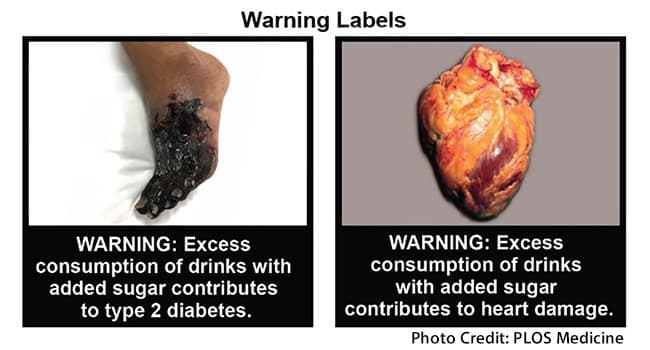Could Warnings on Kids’ Drinks Fight Obesity?
Feb. 7, 2022 — So you’re at the supermarket, and your kid is asking for their favorite fizzy soda. But you’re trying to get your family on a healthier track this year. Do you protest initially, and then give in when the tears start flowing?
Maybe you feel like crying, too. You crave the sugar rush just as much as they do.
This scenario is far too common for families across the country.
Sugary drinks — like juice, soda, decadent lattes, and sports drinks — are the No. 1 source of both calories and added sugar in the American diet, according to the Harvard T.H. Chan School of Public Health. But new research published in the journal PLOS Medicine shows that a picture warning on your child’s favorite soda or juice box could also influence your buying decisions as a parent or caregiver.
The new study from the University of North Carolina at Chapel Hill found that parents were 17% less likely to buy sugary drinks for their kids when the beverages had picture health warnings on the products.
Researchers turned a laboratory setting into a “mini-mart,” and parents were told to choose one drink and snack for their children, along with one household item (to disguise the purpose of the study).
Some parents were presented sweetened drinks that had images reflecting type 2 diabetes and heart damage on the products. Others were shown sugary drinks with a barcode label and no picture warning.
Forty-five percent of parents chose sugary drinks for their children when the products had no picture warning, but only 28% of parents chose sugary beverages when there were picture warnings.
“When people make choices about what food to buy, they are juggling dozens of factors like taste, cost, and advertising and are looking at many products at once,” said the study’s senior author, Lindsey Smith Taillie, PhD, assistant professor in the Department of Nutrition.
“Showing that warnings can cut through the noise of everything else that’s happening in a food store is powerful evidence that they would help reduce sugary drink purchases in the real world.”
Children are particularly prone to over-indulging on sugar, largely due to companies’ frequent marketing displays of pleasurable-looking, and seemingly “thirst-quenching,” sweet beverages.
Drink packaging can also be misleading.
Fruits and veggies displayed on the front of many kids’ beverages often lead parents to buy what they believe are “healthy” options, when these drinks could actually be packed with sugar, according to a recent study in the journal Appetite
Parents are often “doing the best with what information they have,” so more education about nutrition, through picture warning labels, for example, would make a difference, says Caroline Fausel, a Paleo food blogger, podcaster, and author of Prep, Cook, Freeze: A Paleo Meal Planning Cookbook.
Healthier Choices on the Rise
The American Beverage Association, an industry trade group, shared the current steps that major companies are taking help lower Americans’ sugar intake.
Pepsi, Coca-Cola, and Keurig Dr Pepper joined forces in 2014 to create the “Balance Calories Initiative,” which aims to reduce beverage calories in the American diet.
Today, close to 60% of all products sold are zero sugar, according to the trade group.
Coca-Cola offers 250 beverages with zero-to-low calories, and Keurig Dr Pepper has 158 products with 40 calories or less. Pepsi sells 7.5 oz mini-cans, along with various other sizes, to encourage portion control.
“Beverage companies are fully transparent about the calories and sugar in our products, and we are offering more choices with less sugar than ever before,” William Dermody, vice president of media and public affairs for the American Beverage Association, says in a statement.
“We agree that too much sugar is not good for anyone, and clear information about beverages is most helpful to consumers.”
Other big companies are also taking strides to lower sugar content in their products.
Kraft Heinz, the company behind the popular Capri Sun drinks, has publicly shared its efforts to ramp up the nutritional value in its products.
The company has a goal to slash 60 million pounds of total sugar in Kraft Heinz products globally by 2025.
“As more people become aware of the harm that excessive sugar can cause in the body, my hope is that they continue to choose healthier alternatives,” Fausel says.
Creating New Patterns
If your child drinks sweetened juices and sodas regularly, the transition to healthier options might be challenging at first.
“Change can involve tantrums and unhappiness, and right now parents are at their max living pandemic parenting life,” says Jennifer Anderson, a registered dietitian and CEO of Kids Eat in Color, a resource for improving child nutrition and health through innovative education, meal plans, and tools.
“Kids can get used to having sugary drinks and they don’t want to give them up,” Anderson says.
One way to help make the switch is by having only water and milk as options while your child is up and about, a technique that works particularly well for younger children, she says.
“This sort of ‘quiet restriction’ helps kids learn to love the healthier option without feeling deprived,” she says.
“They will eventually learn about juice, soda, chocolate milk, sports drinks, and more, but you can let them learn about those foods at a slower pace when you rarely or don’t serve them at home.”
This technique worked well for Jariana Jimenez, a homemaker and Herbalife distributor.
She hasn’t kept soda and juice at her home since her kids (7 and 3 years old) were babies, and they now see this as “the norm,” says Jimenez, 31.
But modeling the habits you want your kids to adopt is a major factor, too.
“Children are sponges,” Jimenez says. “What we say and do, they will repeat.”
Never Too Late
But what if your children are a little older or your family has already grown accustomed to sweetened drinks?
It’s still not too late to make the switch, says Fausel, who has two children, 8 and 6 years old.
“You can help provide healthy choices for your kiddos, however old they are, and that can help them develop a taste for less sugar and healthier drinks and foods,” she says.
“That foundation will continue to serve them the rest of their lives.”
So how do you make the transition?
Try out different techniques, like weaning your kids off of sugary drinks, suggests Anderson.
For example, parents can try adding a splash of fruit or vegetable juice to their children’s water or adding less sweetener to lemonades and teas.
“As your child gets used to less sweetness, water may become more appealing to them, and your child is drinking less sugar already.”
But most importantly, choose a method that works best for your family.
“Maybe you’re a ‘rip-off-the-Band-Aid’ sort of family, in which case, go for it! Make sure you find some substitutes for fun drinks that your family does enjoy so that no one feels overly deprived,” says Anderson.
Something else to keep in mind: Labeling sugary drinks as “bad” can be confusing for some kids.
Instead, you could explain the health factors associated with sugary drinks, Anderson says.
“The bacteria in our mouth eat sugar, and then they let out acid which makes cavities in our teeth” would be one example, she says.
Making these major changes to your kids’ drinking habits might sound taxing, but it may not be as tough as you think.
“Children adjust, that’s the beauty of it,” says Jimenez.




top 10 pharmacies in india https://indiapharmacy.pro/# – top 10 pharmacies in india indiapharmacy.pro
prescription drugs online https://edwithoutdoctorprescription.pro/ ed meds online without doctor prescription
pin-up casino giriş: https://pinupgiris.fun/ pin up güncel giriş
indian pharmacy paypal http://indianpharmacy.icu/# – pharmacy website india indianpharm24.shop